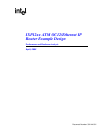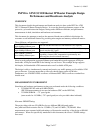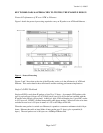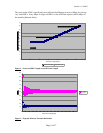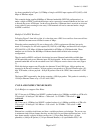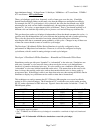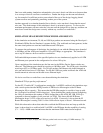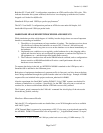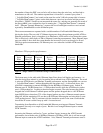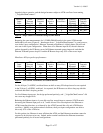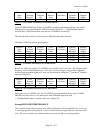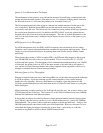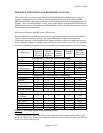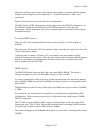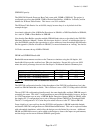
Version 1.0, 4/10/02
Page 8 of 17
One issue with running simulations unbounded to wire-rate is that it can hide errors because there
is no concept of device overflows or underflows. Further the design can become un-balanced,
say for example if an efficient receiver races ahead of the rest of the design, hogging shared
system resources and potentially penalizing another part of the system.
Another approach is to simulate bounded, but to bind to a wire-rate that is faster than the actual
wire-rate. The disadvantage of this technique is that it is an iterative process. To discover the
maximum performance one must raise the wire rate until the design fails to keep up, and then one
must lower it until the design runs correctly without any overflows or underflows.
SIMULATION MEASUREMENT PROCEDURE AND RESULTS
In the simulation environment, 29, 40, and 1500 byte packets are measured using the Developer’s
Workbench IX Bus Device Simulator’s streams facility. The workloads are homogeneous, in that
the same sized packets are sent into both Ethernet and ATM ports.
To measure the performance of the design, the simulation is run with the Ethernet ports bounded
to 100Mbps, and the ATM ports bounded to 155 or 622 Mbps, as appropriate. The simulator is
set to stop if it detects a device overflow or underflow.
Full-bandwidth input streams of the specified packet size are simultaneously applied to all ATM
and Ethernet ports present in the configuration for at least 1M cycles.
Upon completion of the simulation run, the line rates in the IX Bus Device Status window are
observed. The Ethernet ports should be receiving at 100 Mbps each. The ATM port(s) should be
receiving at 622 (or 155 Mbps each). For 29-byte packets, the Ethernet side should transmit at
wire-rate and discard excess ATM input. For 40 and 1500-byte packet workloads the ATM side
should transmit at wire-rate and discard excess Ethernet input.
No device overflows or underflows were detected during the simulation.
Simulated 29-byte packet performance
1
For the OC-12 and 4xOC-3 configurations running the 1 cell/PDU workload, the simulation stops
with a watch-point when the MSGQ from the ATM Receive Microengine to the IP Route
Microengine fills to capacity. This means that the IPR Microengine is not able to keep up with
the 1 lookup/cell workload (1.4M lookups/sec). Upon disabling the watch-point and completing
the 1M cycle simulation, the number of PDUs dropped due to the ATM_RX_IPR_FULLQ is
compared to the total number of cells received via ATM. This shows that the IP Router
Microengine drops 19-22% of the cells received via ATM. Conversely, it shows that the IP
Router Microengine is routing 78-81% of the 1.4M cells/sec input, or about 1.1M routes/second.
While this observation shows that under this workload the IP Router does not keep up with the
input, it shows that for a workload with 2-cell PDUs, the IP Router has the capability of routing
(1.1 – 1.4/2) = 400K routes/second more than the maximum 700K routes/second required.
1
Simulations for 29-byte, 40-byte, and 1500-byte packet loads were run using 133 MHz memory (-75).



